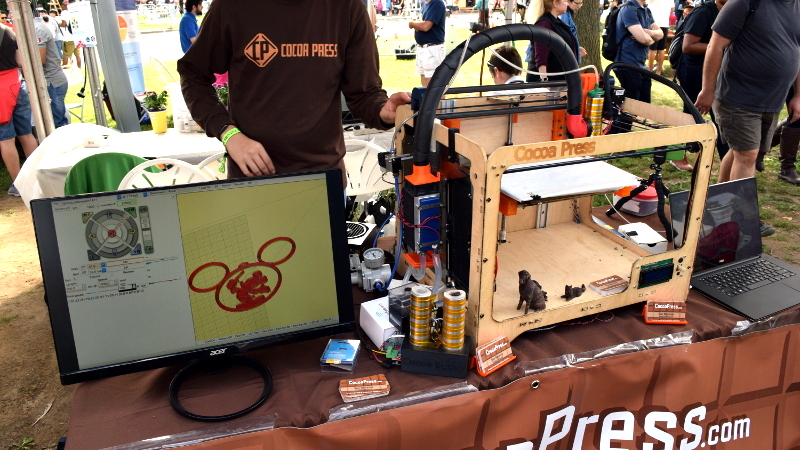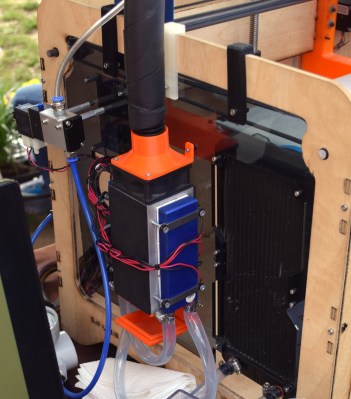If you haven’t figured it out by now, the hype over desktop filament printers is pretty much over. But that doesn’t mean there aren’t new avenues worth exploring that use the basic FDM printer technology. If anything, the low cost and high availability of 3D printer parts and kits makes it easier to branch off into new territory. For example, experimenting with other materials which lend themselves to being “printed” layer by layer like a thermoplastic. Materials such as cement, clay, or even chocolate.
 [Ellie Weinstein] brought her Cocoa Press printer to the 2018 World Maker Faire in New York, and we have to say it’s a pretty impressive piece of engineering. Hackers have been known to throw a syringe-based paste extruder onto a regular 3D printer and try their luck with squirting out an edible object from time to time, but the Cocoa Press is truly a purpose built culinary machine.
[Ellie Weinstein] brought her Cocoa Press printer to the 2018 World Maker Faire in New York, and we have to say it’s a pretty impressive piece of engineering. Hackers have been known to throw a syringe-based paste extruder onto a regular 3D printer and try their luck with squirting out an edible object from time to time, but the Cocoa Press is truly a purpose built culinary machine.
Outwardly it features the plywood case and vaguely Makerbot-looking layout that we’ve seen plenty of times before in DIY 3D printers. It even uses the same RAMPS controller running Marlin that powers your average homebrew printer. But beyond these surface similarities, the Cocoa Press has a number of purpose-built components that make it uniquely qualified to handle the challenges of building with molten chocolate.
For one, beyond the nozzle and the walls of the syringe, nothing physically comes into contact with the chocolate to be printed; keeping the mess and chance of contamination to a minimum. The leadscrew actuated plunger used in common paste extruders is removed in favor of a purely air powered system: a compressor pumps up a small reservoir tank with filtered and dried air, and the Marlin commands which would normally rotate the extruder stepper motor are intercepted and used to trigger an air valve. These bursts of pressurized air fill the empty area above the chocolate and force it out of the 0.8 mm nozzle.
In a normal 3D printer, the “melt zone” is tiny, which allows for the heater itself to be relatively small. But that won’t work here; the entire chocolate load has to be liquefied. It’s a bit like having to keep a whole roll of PLA melted during the entire print. Accordingly, the heater on the Cocoa Press is huge, and [Ellie] even had a couple spare heaters loaded up with chocolate syringes next to the printer to keep them warm until they’re ready to get loaded up.
Of course, getting your working material hot in a 3D printer is only half the battle, you also need to rapidly cool it back down if you want it to hold its shape as new layers are placed on top of it. A normal 3D printer can generally get away with a little fan hanging next to the nozzle, but [Ellie] found the chocolate needed a bit of a chill to really solidify.
So she came up with a cooling system that makes use of water-cooled Peltier units. The cold side of the Peltier array is inside a box through which air is forced, which makes its way through an insulated hose up to the extruder, where a centrifugal fan and 3D printed manifold direct it towards the just-printed chocolate. She reports this system works well under normal circumstances, but unusually high ambient temperatures can overwhelm the cooler.
While “the man” prevented show goers from actually eating any of the machine’s creations (to give out food in New York, you must first register with the city), they certainly looked fantastic, and we’re interested in seeing where the project goes from here.

















Pretty clever keeping spares on the back burner. Any 3D printed poop emojis?
for german-speaking people: https://cdn.webfail.com/upl/img/fdf0d82fa0a/post2.jpg
They look more like a ripoff of ‘schlock’ from schlockmercenary.com
german humor at other side of spectrum from martina hill I suppose?
Actually the picture seems made in Switzerland. (And i don’t know Martina Hill.)
The use of air instead of a lead screw seems annoyed choice, as air is compressible, and leadscrews aren’t. Isn’t this likely to give blobby prints? Given that a leadscrew the normal and likely easier choice, does anyone know why he didn’t use one? I couldn’t see anything on design decisions on the site.
Also, it’s a shame that the waste heat from the peltiers isn’t used to melt the chocolate.
Good work nonetheless.
It’s explained in the post, he didn’t want to deal with a sticky plunger. Nothing touches the chocolate now but air. He can just pop out the tube and put a new one in without trying to retract a plunger and making a big mess.
More to the point I don’t know why you’d think this is difficult to master. It’s about as complex as blowing up a balloon. More air goes in, more chocolate comes out. With a 0.8 mm nozzle, doesn’t seem like fine details are much of a concern to begin with.
Ah, no plunger. I can see the advantage there.
What’s difficult to master? Blowing up a balloon demonstrates it nicely. The air compresses under pressure, and so pumping 1cm3 of air into a balloon doesn’t increase the balloon’s volume by 1cm3.
I’d expect exactly the same issue using air to extrude. Pump in 1cm3 of air, but instead of 1cm3 of chocolate coming out, the pressure in the syringe increases slightly instead. Pump in another 1cm3 of air, and the chocolate decides to move and 2cm3 of chocolate is dispensed. It’s exactly the same problem as squeezing superglue or toothpaste from the tube once there’s air in the tube – it won’t come out smoothly, but in spurts.
Perhaps if the chocolate is very hot instead of just above melting point and the viscosity is much lower then it’d work reliably, but then you’ve got much hotter chocolate to cool.
What about peristaltic pump? Wouldn’t that be a good alternative to leadscrew?
Not sure you’d get continuous flow using a peristaltic pump.
In China, there is a sugar painting machine that has been invented for several years.,
https://item.taobao.com/item.htm?spm=a230r.1.14.16.3d771c73UIaEx7&id=564472428987&ns=1&abbucket=9#detail